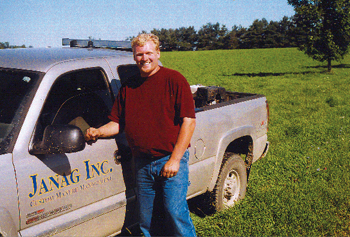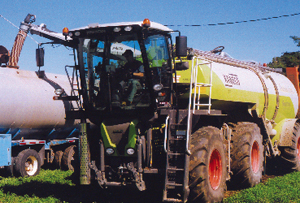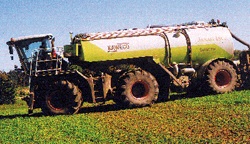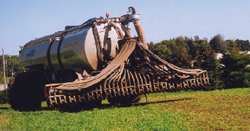
JANAG Custom Manure Management has
recently expanded its equipment line-up with a new injection unit from
Claas of Germany and Kaweco of the Netherlands — the first machine of
its kind to operate in North America — and is now working to grow its
manure injection business with dairy and hog farm operators.
JANAG Custom Manure Management has recently expanded its equipment line-up with a new injection unit from Claas of Germany and Kaweco of the Netherlands — the first machine of its kind to operate in North America — and is now working to grow its manure injection business with dairy and hog farm operators.
 Jeremy Noble (above) of JANAG Custom Manure Management says more farmers are seeing the benefits of using custom applicators. “We’re starting to see movement towards custom application. It frees up the farmer’s time so they can focus on what is most important to them: the livestock.” Jeremy Noble (above) of JANAG Custom Manure Management says more farmers are seeing the benefits of using custom applicators. “We’re starting to see movement towards custom application. It frees up the farmer’s time so they can focus on what is most important to them: the livestock.” |
Jeremy Noble of JANAG Custom Manure Management has a favorite story when explaining just how effective his injection equipment is at reducing odor. The company’s equipment was doing manure injection work on farmland near the north shore of Lake Erie. There are a number of wind turbines nearby, and a group was touring the wind power site. One of the sightseers asked Noble what his manure injection equipment was doing.
“So I asked the fellow, what did he think we were doing? He told me he thought we were sucking dew worms up out of the ground with the toolbars, putting them into the tanks, and taking them up north for fishing. When we told him we were spreading manure, he didn’t believe it—he couldn’t smell anything.”
That’s the kind of response Noble has run into on a regular basis since he started JANAG Custom Manure Management with its manure injection equipment two years ago. And while he says getting the business going hasn’t always been easy—in spite of the effectiveness of his equipment—word is getting around, and the company is starting to get some traction, with business growing.
 The Claas/Kaweco injection unit fills up from one of four 10,000-gallon semi-tanker trailers that JANAG uses in its application operations. The Claas/Kaweco injection unit fills up from one of four 10,000-gallon semi-tanker trailers that JANAG uses in its application operations. |
“This equipment is great,” he says. “You can go near a densely populated area, spread the manure and people nearby won’t even know what you are doing because there’s no odor. That’s the ultimate in spreader technology when you can do that near an urban setting.”
Clearly, Noble has a good case to make for manure injection to the dairy and hog farms around this region, which is a couple of hours northeast of Detroit, Michigan, in the Canadian province of Ontario.
“There are farmers out there that feel their surface application systems work just fine, and they do work fine,” he says. “But if you take the next step, pay a little bit more upfront to get the manure injected, you’ll end up with some significant savings on fertilizer down the road, especially with the price of nitrogen and phosphorus right now.”
Noble notes that one dairy farm customer saved over $85,000—that being how much he did not have to spend on commercial fertilizer, opting to inject manure on his croplands. And that is net savings, after paying JANAG for its application services.
Doing work for JANAG from the start has been a Terra-Gator 3104, currently the only Terra-Gator in the province of Ontario, which Noble describes as a real workhorse, providing JANAG and its customers with steady service. It applied more than 30 million gallons in the company’s first year of operation. “We’ve run the Terra-Gator 18 to 20 hours a day, seven days a week, from April through to Christmas, and it’s done a phenomenal job,” he says. “It’s able to do 350,000 gallons a day.”
The most recent addition to the equipment line-up at JANAG, however, is a new injection unit from Claas of Germany and Kaweco of the Netherlands, the first machine of its kind to operate in North America. Noble says that he, like many people in the industry, has heard that the Europeans are ahead of North America in manure application technology. “Now that I’ve seen the equipment and we’re using it, that is 100 percent true.”
European countries have been facing strict manure application regulations, smaller land bases and “urban creep” for many years, and they’ve developed equipment to deal with this scenario. “They were having these kinds of problems 20 years ago, and they’ve designed their technology around that,” Noble says.
A gradual increase in business led Noble to purchase the Claas/Kaweco, which has tripled the company’s manure injection capabilities. He’s now looking to build the business further to maximize use of his equipment. Growth has been steady since he acquired the new unit early last year, and he’s hoping that will continue. “I think this could take off and we might have four or five machines working here in three or four years,” he says.
 The Claas/Kaweco has the ability to crab steer. Each tire runs on its own path, reducing repetitive compacting. The Claas/Kaweco has the ability to crab steer. Each tire runs on its own path, reducing repetitive compacting. |
With the Claas/Kaweco and the Terra-Gator, JANAG can now do a million gallons of manure injection a day. “If we’re not moving and don’t have to jockey around with toolbars and trucks, and have pits we can pull out of all day, we can easily hit a million gallons.” The equipment delivers controlled rates of anywhere from 3,000 to 20,000 gallons per acre.
JANAG has done some marketing in the region, with brochures featuring the new equipment. And while a picture may be worth a thousand words, for farmers the proof is in actually seeing the equipment work. The company did some recent demos, including for the Large Herd Operators of Ontario, a group of the larger dairy operators in the province.
An item of interest for farmers is that Noble takes a bit different approach with the application services. A spring or fall tillage pass is included as part of the direct injection package. One less pass over the field for the farm means less wear on equipment, less fuel required and, just as importantly, frees up the farmer’s time to do other things.
“We try and tie it all in together—doing the tillage pass probably saves the farm $15 to $20 an acre on its input costs.”
But it’s really the injection system that is getting the most attention. “We’ve really been able to develop a niche doing this,” says Noble. “There are guys out there that do top spreading and knifing it in to get it into the ground. But we’ve taken it one step further.”
The results of manure injection often speak volumes. JANAG has done studies on the crop results of injection versus surface spreading on alfalfa, with 4,000 gallons of dairy manure per acre application. “The results were unbelievable from both the height and weight standpoints.” Noble says that some customers who normally would take four cuts of alfalfa are now taking two-and-a-half cuts because their silos are full.
A separate trial was done with hog manure. “We’re waiting for the yield map to come back on some winter wheat but it looks like it’s going to be 110 bushels an acre with the manure versus 88 bushels with commercial fertilizer. Either way, those are excellent crop numbers, but we were able to deliver more.” And in an economical way, he adds.
Working with associates in manure management in Indiana, Noble has developed a software program that takes all the input costs and shows a farmer exactly what having his own manure management equipment and program costs. “There are some higher costs to injection, but if they take into account the time, the expenses of the tractor, the tanker equipment and the fuel—all of that—99 times out of 100, they are saving money compared to doing it themselves.”
Noble notes that while a farmer may think his application costs are only .8 to one cent a gallon, they may, in fact, be upwards of three cents a gallon once all these costs are factored in. “And a lot of farmers don’t take into account that their time is worth something—and that is true. Any time they spend applying manure is time they could be spending on other activities on the farm.”
Going to custom application means farms are able to essentially offload the capital costs and maintenance costs of manure application equipment to the applicator, admittedly for a price. That said, applicators have to be extremely efficient and prices are usually pretty competitive, says Noble. “The only way we can do it for what we charge is through sheer volume. Instead of doing the two or three million gallons a year a single farm would do, we’re doing tens of millions of gallons in a year.”
And they do that work with a light footprint, carrying small tankloads into the field. The Terra-Gator holds 4,000 gallons and runs on four 75 R44 tires. The Claas/Kaweco carries 6,800 gallons and runs on six tires—four 900/52 R32s and the tank has two 1050/52 R32s. The Claas/Kaweco also has the ability to crab steer. Each tire runs on its own path, reducing the repetitive compacting sometimes associated with larger tankers and tractors.
Noble also took a 40-foot cargo container and has converted it into a 24,000 gallon dump station, where semis unload, and the Terra-Gator and the Claas/Kaweco upload. So the semis never have to enter the fields.
Noble says adding the Claas/Kaweco has motivated them to open up new markets for the company, outside its traditional operating area. They had been operating within a 50-kilometre radius, but now have to go further afield to keep the two machines busy. “That original radius has not provided enough gallons for us, so we’ve made the jump, going further out to get the business.”
They’ve also made an effort to diversify the business between dairy and hog operations and now the spreading of biosolids. JANAG has a good amount of support equipment to keep all this happening, including a variety of toolbars and pumps.
Its Kongskilde tine injector has an 18-foot, six-inch working width, with manure placed every eight inches. The tines have seven-inch sweeps for what Noble says is excellent manure to soil contact. The Kongskilde is excellent as a spring tillage pass, he adds. Several farmers planted corn directly behind manure application with the Kongskilde.
JANAG’s Veenhuis Grassland injector has a 22-inch working width, with manure placed every seven inches. Its nine-inch coulters cut slots half an inch to 1-1/2 inches deep, and rubber boots behind each coulter fill the slots with manure. No damage is done to the ground or crowns of the alfalfa and use of the injector is said to result in up to a 25 percent increase in yield.
The Glencoe Soil Saver JANAG uses has a 12-foot working width, with manure placed every 16 inches. It has working depths of four to eight inches. An 18-inch coulter gang ensures excellent trash cutting ahead of the shovels that provide burying of trash.
On the pump side, the company has a Houle 42-foot lagoon Agi-Pump which Noble says offers excellent agitation and pumping for earthen lagoons. It is also capable of entering into concrete pits with the use of the wall climbing option. It can load a 10,000-gallon trailer in 4-1/2 minutes.
The Boerger under barn pump features high capacity pumping and agitation for those under barn pits with limited space for a pump. It pumps 2,200 gallons per minute for agitation and transfers, and will load a 10,000-gallon tanker in five minutes.
The newest addition on the pump side is a Nuhn 10-foot vertical pit pump. Noble says the Nuhn pump provides tremendous agitation in large under pit barns that are square and require lateral as well as vertical agitation movement. It also will load a 10,000-gallon tanker in five minutes.
JANAG has four 10,000-gallon semi- tanker trailers. The trailers’ capacity allows the Terra-Gator and Claas/Kaweco two full pulls (loads) off of each truck.
Overseeing all this equipment requires a solid ag background. Noble, who has an agricultural diploma from Ontario’s Ridgetown College, worked for a local ag-related company before starting up JANAG. He is a licenced nutrient management consultant and a licenced custom applicator.
Noble was developing nutrient management plans for local farms when the light came on for starting a business. “That’s when I saw that this equipment would fit in very well. We can take the nutrient management plan, print the reports, and plug them into the computer on the machine. The operators on the machine don’t have to worry about getting directions on leaving buffers or staying back from a creek—it’s all mapped out for them. The farmer is happy with the end result and so is the government.” If any of the farms are questioned by government ag people on their manure application, there’s a paper trail of manure application, and maps are generated so farms have a record of the precise area where manure has been applied.
That being the case, it’s not surprising that more farmers are seeing the benefits of using custom applicators, says Noble. “We’re starting to see movement towards custom application, regardless of the type of equipment being used,” he says. “It takes a lot of the liability off them, and it frees up time so they can focus on what is most important to them, the livestock.”
 Using the company’s own mapping system, JANAG’s Jeremy Noble does the plotting himself and then enters the data into the Claas/Kaweco (above) and the company’s Terra-Gator 3104. Both units are equipped with GPS systems. Using the company’s own mapping system, JANAG’s Jeremy Noble does the plotting himself and then enters the data into the Claas/Kaweco (above) and the company’s Terra-Gator 3104. Both units are equipped with GPS systems. |
With the company’s mapping system, Noble does the plotting himself, and then enters the data into the Terra-Gator and the Claas/Kaweco. “Our operators are very capable of working with the plots on a manual basis if they need to, but the computers on the machines run everything, and it’s done 100 percent accurate every time.” Both the Terra-Gator and the Claas/Kaweco are equipped with GPS systems.
The province of Ontario provides custom operations with a custom nutrient management software program, NMAN. The NMAN program assists applicators and farmers in predicting nutrient generation and determining land base requirements for agronomic use of nutrients. This Windows 98/2000/NT/XP compatible system can track nutrient and manure applications, and considers both agronomic and crop removal nutrient application rates.
“We essentially take the information from NMAN and then plug it into the software on the machines,” says Noble. “It’s a pretty decent program. It can be a bit time consuming, but it does what it’s supposed to.”
In addition to custom application, Noble also does manure brokering for dairy and hog operations in the region. “If they don’t have the land, we’ll find the land for them. We’ll put together an agreement with cash croppers in the area and set up a rotation to spread the manure. It’s worked out really well, with a sharing of the costs.”